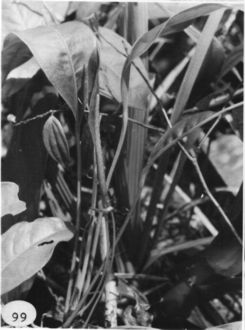




Anthurium gracilispadix Croat, sp. nov.
TYPE: Panama. Chiriquí: Cerro Colorado 1,500 m, António 1516 (MO 2782431, holotype; PMA, isotype).
Planta plerumque epiphytica, raro terrestris; cataphyllum findens in fibris tenuibus; petiolus 4-14 cm longus, adaxiale camplanatus; lamina membranacea, oblongo-elliptica ad lanceolato-elliptica, basi anguste acute ad attenuata, (8-)11-18 cm longa, 3-5.5 cm lata, utrinque glanduloso-punctata; inflorescentia et folia aequilongae; pedunculus 10-20 cm longus, teres ad leviter tri-costatus; spatha modice membranacea, viri-dis interdum suffusa rubra, lanceolata; spadix viridis, 5-9.5 cm longus; baccae pallide viridis, subglobosae, ca. 6 mm diam.
Plants usually epiphytic, rarely terrestrial; stems less than 5 cm long, less than 1 cm diam.; internodes short; leaf scars hidden by cataphylls; roots numerous, slender, spreading or directed downward; cataphylls 2.5-3 cm long, promptly weathering to slender, reddish brown fibers.
LEAVES semierect; petioles 4-14 cm long, one-half to three-fourths as long as the blades, flattened adaxially with erect margins, rounded abaxially; geniculum to 1 cm long; blades thin, oblong-elliptic to lanceolate-elliptic, gradually sharp-acuminate at apex, narrowly acute to attenuate at base, (8-)11-18 cm long, 3-5.5 cm wide, broadest usually near the middle, drying thin, grayish green; both surfaces matte to semiglossy, glandular-punctate; midrib acutely raised above, weakly, convexly raised below; primary lateral veins 4÷9 per side, departing midrib at ca. 45° angle, etched in surface above, prominulous below, directed straight to collective vein, weakly loop-connected, scarcely raised on both surfaces on drying; interprimary veins present, drying only slightly less conspicuous than the primary lateral veins.
INFLORESCENCE usually about as long as the leaves, rarely slightly longer; peduncle 10-20 cm long, ca. 2 mm diam., equalling or to twice as long as petioles, terete to weakly 3-ribbed; spathe moderately thin, green, sometimes tinged with red, spreading, lanceolate, 2.5-5 cm long, 4-8 mm wide, broadest below the middle, acuminate at apex, inserted at 45° angle on peduncle; spadix sessile or nearly so, green, 5-9.5 cm long, to 2 mm diam. at base, ca. 1 mm diam. near apex; the flowers (dried) rhombic, 3-4.2 mm long, 1.8-3 mm wide, 2÷3 flowers visible in principal spiral, 3-4 visible in alternate spiral; tepals semiglossy, coarsely granular-punctate, the lateral tepals 2.7-3.5 mm wide, the inner margin straight to weakly concave, the space between the tepals 2.5-3.5 mm long, elongated in the direction of the axis; pistil not emergent; stigma linear; stamens not exposed on dried specimens, presumably emerging briefly, then retracting beneath the tepals.
INFRUCTESCENCE with pale green, subglobose berries, ca. 6 mm diam. Fig. 99.
Anthurium gracilispadix is endemic to western Panama at 800 to 1,500 m in premontane rain and lower montane rain forest. Most collections have been made from Cerro Colorado but a collection from the Fortuna Dam Road (Croat 49999) and one from Santa Fe (Veraguas) (Folsom 2973) are perhaps also this species.
The species is a member of section Porphyrochitonium and is characterized by its thin, oblong-elliptic top lanceolate-elliptic, glandular-punctate (both surfaces) blades that are gradually sharp-acuminate at the apex, narrowly acute to attenuate at the base and dry gray-green with inconspicuous veins. Also characteristic is the narrow, sharply tapered, green spadix.
Due to similar blade shapes it can be confused with the smallest specimens of A. lancifolium, but that species has a relatively short, stubby, whitish or grayish white spadix. Anthurium gracilispadix is perhaps most similar to A. Oxystachyum, which has leaves of similar size and a similar, sharply tapered green spadix. The latter species differs, however, in having leaf blades eglandular on the upper surface and obtuse to subrounded at the base.
Although tentatively placed Anthurium gracilispadix, Hammel 2302 differs in having proportionately longer blades that dry brown rather than gray-green and in having a proportionately longer spadix with thicker tepals.

Map of Mesoamerican specimens with coordinates
Panama Bocas del Toro: 600 m, 8.47N 82.12W, 12 Mar 1985, Hampshire &
Whitefoord 521 (BM).
Panama Bocas del Toro: 1200 m, 8.45N 82.15W, 4 Dec 1985, Gordon McPherson
7743 (MO).
Panama Bocas del Toro: 1000 m, 8.45N 82.15W, 8 Dec 1985, Gordon McPherson
7851 (MO).
Panama Bocas del Toro: 1150 m, 8.45N 82.15W, 22 Oct. 1985, Gordon McPherson
7222 (MO).
Panama Bocas del Toro: 1150 m, 8.45N 82.15W, 22 Oct. 1985, Gordon McPherson
7229 (MO).
Panama Bocas del Toro: 1150 m, 8.45N 82.15W, 22 Oct. 1985, Gordon McPherson
7238 (MO).
Panama Chiriquí: 1100 m, 8.47N 82.12W, 21 March 1985, Hampshire &
Whitefoord 787 (BM).
Panama Chiriquí: 1150 m, 8.45N 82.15W, 24 Oct. 1985, Gordon McPherson
7309 (MO).
Panama Chiriquí:, 7 December 1997, D.W. Roubik & L. Quroz 1285
.
Panama Chiriquí:, 7 December 1997, D.W. Roubik & L. Quroz 1267
.